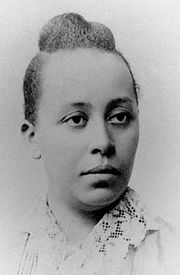Halle Tanner Dillon Johnson facts for kids
Quick facts for kids
Halle Tanner Dillon Johnson
|
|
|---|---|
 |
|
| Born |
Halle Tanner
October 17, 1864 |
| Died | April 26, 1901 (aged 36) |
| Alma mater | Woman's Medical College of Pennsylvania |
| Scientific career | |
| Fields | General medicine |
| Institutions | Tuskegee Institute |
Halle Tanner Dillon Johnson (October 17, 1864 – April 26, 1901) was an American doctor. She made history by becoming the first Black woman, and the first woman of any race, to be officially licensed as a doctor in Alabama.
Contents
Biography
Early Life and Education
Halle Tanner was born in Pittsburgh, Pennsylvania. She was the oldest daughter of Benjamin Tucker Tanner and Sarah Elizabeth Tanner. Her parents were well-known and respected people in the local African-American community.
Halle was the oldest of nine children. Her father, Benjamin, was a minister at the African Methodist Episcopal Church in Pittsburgh. He also wrote several books. Halle helped him publish the Christian Recorder, a newspaper for the church. Her brother, Henry Ossawa Tanner, became a famous painter. Her niece, Sadie Tanner Mossell Alexander, was the first Black woman in the United States to earn a Ph.D.
In June 1886, Halle married Charles Dillon. Sadly, he died from pneumonia about two years later. They had a daughter named Sadie in 1887. After her husband's death, Halle Dillon returned home to her family. At age 24, she decided to study medicine. She enrolled at the Woman's Medical College of Pennsylvania. She graduated with honors in 1891.
Around the time she finished medical school, Booker T. Washington was looking for an African-American doctor. He was the founder of the Tuskegee Institute in Alabama. Halle Dillon accepted his offer soon after her graduation.
Later Life and Family
In 1894, Halle Johnson married John Quincy Johnson. He was a mathematics professor at Tuskegee. She stopped working at Tuskegee when they moved to Columbia, South Carolina. Her husband became the president of Allen University, a private school for Black students.
Later, they moved to other cities for his studies in theology. They lived in Hartford, Connecticut, Atlanta, Georgia, and Princeton, New Jersey. Halle and John had three sons together: John Quincy Jr., Benjamin T., and Henry Tanner. In 1900, the Johnsons moved to Nashville, Tennessee. There, John became a minister at Saint Paul's AME Church.
Death and Burial
Halle Tanner Dillon Johnson died on April 26, 1901. She passed away from dysentery, a serious stomach illness, during childbirth. She is buried in Nashville's Greenwood Cemetery.
Medical Career
When Dr. Dillon arrived in Alabama, she prepared for her medical exam. Dr. Cornelius N. Dorsette tutored her. The exam was a tough, ten-day oral test. Leading doctors in the state gave the exam. She applied on August 17, 1891, and started the exam soon after.
This difficult exam required written answers to spoken questions. These questions came from the state health office. Dr. Dillon scored 78.81%, which was 3.81% higher than the passing score of 75%.
Many people watched her closely because of her race and gender. But she successfully passed the exam. She became the first woman doctor in Alabama.
Dr. Johnson worked at Tuskegee Institute from 1891 to 1894. Her father, Bishop Benjamin Tanner, also lectured there for a year. At Tuskegee, Dr. Johnson taught anatomy and hygiene. She taught up to two classes each school term.
She also took care of the health of many people. She oversaw the medical care for 480 students, their families, and the school's staff. Dr. Johnson even made her own medicines to treat them. She also had to mix medicines for the town and the institute.
Her work at Tuskegee Institute earned her a salary of 600 dollars a year. This also included her room and board. She received a month of vacation each year. She also started a nursing school there. In addition, she practiced medicine and mixed medicines for the community. She founded the Lafayette Dispensary to help local people.
See also
 In Spanish: Halle Tanner Dillon Johnson para niños
In Spanish: Halle Tanner Dillon Johnson para niños

